
Following the Beagle
In the wake of some true explorers
Continued From:
Part 1
Stage 4 Congruences
The Cone of South America
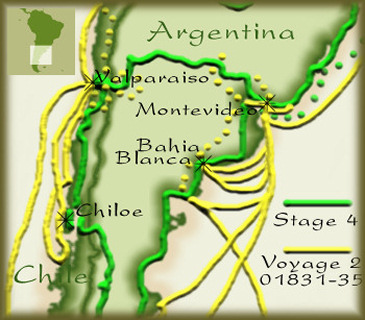
Buenos Aires, being the largest metropolitan area that I rode through during the Tour, probably did not significantly resemble the city that the crew of the Beagle saw when they called. It did provide a reasonable base from which I would begin Stage 4, however.
Mr. C. R. Darwin:"The city of Buenos Ayres is large; and I should think one of the most regular in the world. Every street is at right angles to the one it crosses, and the parallel ones being equidistant, the houses are collected into solid squares of equal dimensions, which are called quadras. On the other hand, the houses themselves are hollow squares; all the rooms opening into a neat little courtyard. They are generally only one story high, with flat roofs, which are fitted with seats, and are much frequented by the inhabitants in summer. In the centre of the town is the Plaza, where the public offices, fortress, cathedral, &c., stand. Here also, the old viceroys, before the revolution, had their palaces. The general assemblage of buildings possesses considerable architectural beauty, although none individually can boast of any."
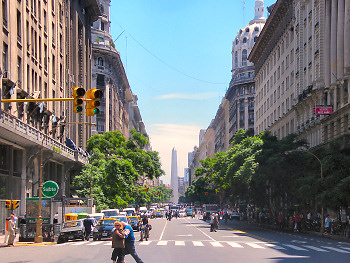
Buenos Aires centro
Heading south, eastern Patagonia provides only a few places of use or interest to cyclists along its windswept eastern coast. Many of those are places that also existed during the era of the Beagle voyages, though some places have come and gone. One that was visited by me, as well as Darwin, was the nice little town of Carmen de Patagones, on the Rio Negro at the southern tip of Buenos Aires Province. If there was ever any confusion about the name of the town, that seems to have been settled by adopting both options.
Mr. C. R. Darwin:"The town is indifferently called El Carmen or Patagones. It is built on the face of a cliff which fronts the river, and many of the houses are excavated even in the sandstone. The river is about two or three hundred yards wide, and is deep and rapid. The many islands, with their willow-trees, and the flat headlands, seen one behind the other on the northern boundary of the broad green valley, forms, by the aid of a bright sun, a view almost picturesque. The number of inhabitants does not exceed a few hundreds. These Spanish colonies do not, like our British ones, carry within themselves the elements of growth. Many Indians of pure blood reside here: the tribe of the Cacique Lucanee constantly have their Toldos * on the outskirts of the town. The local government partly supplies them with provisions, by giving them all the old, worn out horses, and they earn a little by making horse-rugs and other articles of riding gear."
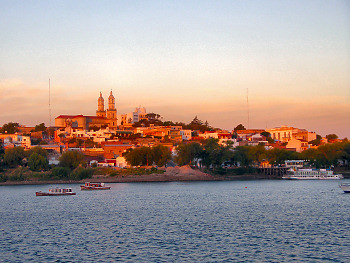
Carmen de Patagones
A sign outside this establishment, on the Carmen
de Patagones waterfront, notes its historical importance as "A classic bar of the late 19th century". That may
mean it was not yet present during Darwin's visit, but if it were, one
could easily imagine him downing a pint or two there.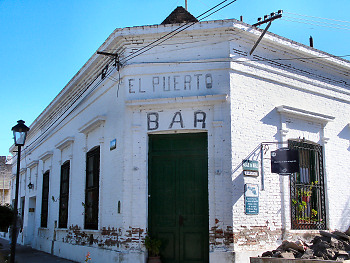
El Puerto Bar, in Carmen de Patagones
Mr. C. R. Darwin:
"The next day the country continued similar to that above described. It is inhabited by few birds or animals. Occasionally a deer, or a Guanaco (wild Llama) may be seen; but the Agouti (Cavia Patagonica) is the commonest quadruped. This animal here represents our hares. It differs, however, from that genus in many essential respects; for instance, it has only three toes behind. It is also nearly twice the size, weighing from twenty to twenty-five pounds. The Agouti is a true friend to the desert; it is a common feature in the landscape to see two or three hopping quickly one after the other in a straight line across these wild plains."
I believe that Darwin may have misidentified this animal. The Agouti is a somewhat smaller, though also rather tall, rodent found in northern South America. There is some amount of confusion, however, as the name Agouti has been used for more than one genus over the years. Certainly we can give one of the greatest naturalists of all time a little leeway in this case, especially as he used the correct scientific name. It was clear to me that the Mara, as the species is properly known, is not nearly as common today, as it had been in Darwin's time. In fact, these three were the only ones I saw during my many weeks in Patagonia.
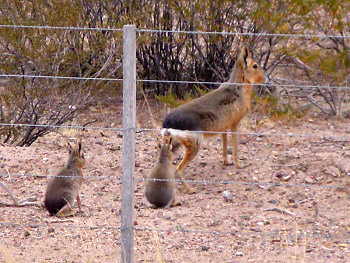
A Mara and its young in Patagonia
During voyage one, the ship called at a place known as Port Santa Elena, somewhat south of modern day Trelew. Today, nothing exists of that former seaport. The only notation on maps these days is a tiny place named Cabo Raso, but as I passed by I only observed a few, mostly decrepit, and likely abandoned, buildings. It is still a quite barren place that I only rode though, along a lonely, sandy road, because it provided a short-cut back to the main highway from the penguin colony at Punta Tombo.
Capt. R. Fitz-Roy:"Our course was therefore southerly, and in latitude 45° south, a few leagues northward of Port Santa Elena, we first saw the coast of Patagonia. I intended to visit that port; and, on the 28th, anchored, and landed there. Seamen should remember that a knowledge of the tide is of especial consequence in and near Port Santa Elena. During a calm we were carried by it towards reefs which line the shore, and were obliged to anchor until a breeze sprung up. The coast along which we had passed, from Point Lobos to the north-east point of Port Santa Elena, appeared to be dry and bare of vegetation. There were no trees; the land seemed to be one long extent of undulating plain, beyond which were high, flat-topped hills of a rocky, precipitous character. The shore was fronted by rocky reefs extending two or three miles from high-water mark, which, as the tide fell, were left dry, and in many places were covered with seals. As soon as we had secured the ships, Captain Stokes accompanied me on shore to select a place for our observations. We found the spot which the Spanish astronomers of Malaspina's Voyage (in 1798) used for their observatory, the most convenient for our purpose. It is near a very steep shingle (stony) beach at the back of a conspicuous red-coloured, rocky projection which terminates a small bay, on the western side, at the head of the port. The remains of a wreck, which proved to be that of an American whaler, the Decatur of New York, were found upon the extremity of the same point; she had been driven on shore from her anchors during a gale."
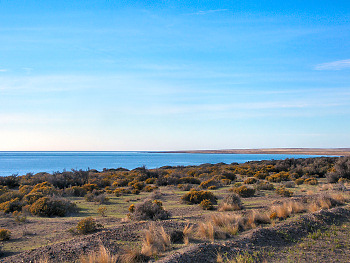
Deserted coastline at Cabo Raso, formerly Port Santa Elena
I found guanacos to be among the most appealing creatures I saw during the Tour. They appeared to have made an impression on the crew of the Beagle as well, as they are mentioned frequently and described in detail in their accounts. However, that could also be because they provided a valuable source of meat for mariners of that age. I did not need to hunt for food on the Tour, though in the more desolate areas of Patagonia I almost had to on a few occasions. I'm sure the local guanacos would have had nothing to fear from me, however.
Mr. C. R. Darwin:"I will here give an account of this latter animal, which is very common, and is the characteristic quadruped of the plains of Patagonia. The Guanaco, which by some naturalists is considered as the same animal with the Llama, but in its wild state, is the South American representative of the camel of the East. In size it may be compared to an ass, mounted on taller legs, and with a very long neck. The guanaco abounds over the whole of the temperate parts of South America, from the wooded islands of Tierra del Fuego, through Patagonia, the hilly parts of La Plata, Chile, even to the Cordillera of Peru. Although preferring an elevated site, it yields in this respect to its near relative the Vicuna. On the plains of Southern Patagonia, we saw them in greater numbers than in any other part. Generally they go in small herds, from half a dozen to thirty together; but on the banks of the St Cruz we saw one herd which must have contained at least five hundred. On the northern shores of the Strait of Magellan they are also very numerous.Generally the guanacoes are wild and extremely wary. Mr. Stokes told me, that he one day saw through a glass a herd of these beasts, which evidently had been frightened, running away at full speed, although their distance was so great that they could not be distinguished by the naked eye. The sportsman frequently receives the first intimation of their presence, by hearing, from a long distance, the peculiar shrill neighing note of alarm. If he then looks attentively, he will perhaps see the herd standing in a line on the side of some distant hill. On approaching them, a few more squeals are given, and then off they set at an apparently slow, but really quick canter, along some narrow beaten track to a neighbouring hill. If, however, by chance he should abruptly meet a single animal, or several together, they will generally stand motionless, and intently gaze at him; then perhaps move on a few yards, turn round, and look again."
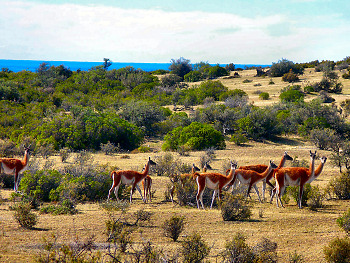
Guanacos near the Atlantic
South of Comodoro Rivadavia, and about 20 kilometers from the coast, there is a tiny town called Fitzroy. I assume that this was named after the Captain of the Beagle, though I can find no mention of it in any descriptions of the voyages. Today, it is merely a small roadside collection of a few tens of buildings without much to offer a passing tourist. That is probably why my only picture from the area is this view of the sunrise at my nearby campsite.
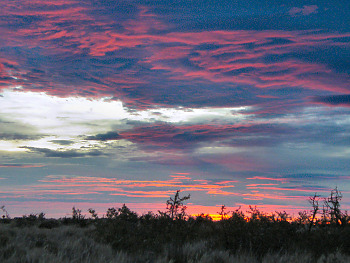
Dawn at Fitzroy, Argentina
Puerto San Julian provides cyclists one of only two decent service stops along an 800-km stretch of coast between Comodoro Rivadavia and Rio Gallegos. The Beagle called there as well, but did not seem to find the port as useful as I did.
Mr. C. R. Darwin:"Before it was dark the Beagle anchored in the fine spacious harbour of Port St. Julian, situated about one hundred and ten miles to the south of Port Desire. We remained here eight days. The country is nearly similar to that of Port Desire, but, perhaps, rather more sterile. One day a party accompanied Captain Fitz-Roy on a long walk round the head of the harbour. We were eleven hours without tasting any water, and some of the party were quite exhausted. From the summit of a hill (since well named Thirsty Hill) a fine lake was spied, and two of the party proceeded with concerted signals to show whether it was fresh water. What was our disappointment to find a snow-white expanse of salt, crystallized in great cubes! We attributed our extreme thirst to the dryness of the atmosphere; but whatever the cause might be, we were exceedingly glad late in the evening to get back to the boats."
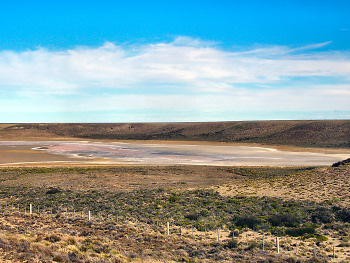
A saline pond at Puerto San Julian
Today there is abundant marine life in the harbor
there, including a large number of birds. Darwin did not make mention of
that, though that could be because, in that era, so many places along the
coast were equally bountiful. The town itself seemed to me, perhaps, to
have only changed slightly from the way it must have looked in the 19th
century.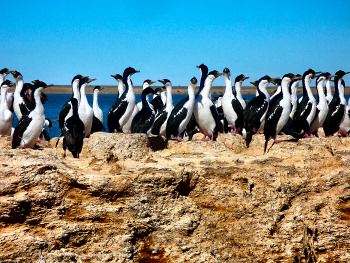
Many cormorants at Puerto San Julian
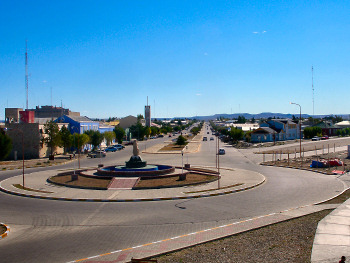
Puerto San Julian
Tierra del Fuego
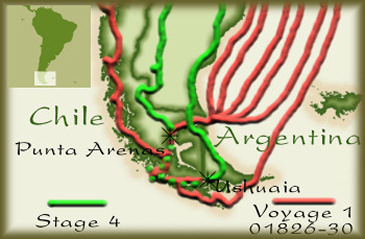
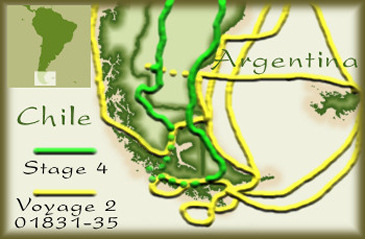
After many months, and a lot of cycling, I had finally reached Tierra del Fuego, near the southernmost point of my Tour. Surveying the waterways around that chilly island was the primary focus of the first two voyages of the Beagle. Consequently, the ship spent a considerable length of time in the area. That fact resulted in ample opportunities to see the same sights that its crew had, though many of the more intriguing candidates were still beyond my reach. In a nice twist, I crossed paths with the ship, on more than one occasion, while I was on the water myself.
The first instance of that was when I cross the Strait of Magellan for the first time. That crossing was at a place known as the "First Narrows," a thin section of the Strait infamous for causing hardships to those attempting to sail against the prevailing westerly gales. The Beagle had such difficulties on both voyages, but less so during the second thanks, in part, to Fitz-Roy's refit of the ship between the journeys. My crossing was much less problematic. I arrived at the Punta Delgda ferry moments before its next departure, and within minutes was across the Strait on Tierra del Fuego. An added luxury that was available to me, but not to the crew of the Beagle was steaming hot-dogs and coffee available in the ferry's simple galley.
Capt. R. Fitz-Roy:"Early on the 14th we made another fruitless attempt to pass the First Narrow. As the Adelaide sailed under our stern, Lieutenant Graves informed me that he had lost an anchor, and had only one left, to which he had bent his chain-cable; and that she had shipped so much water in attempting to beat through, that he was on the point of asking permission to bear up when we ourselves gave up the attempt. It blew too hard to give any assistance to the Adelaide, but next morning, when the weather was more moderate, I seized an opportunity of sending our two kedge anchors; and in the afternoon we supplied her with some water and other necessaries, so that she was comparatively well off, and my anxiety on her account much relieved.Fires on the Fuegian side had been kept up since our arrival, but we could not distinguish any inhabitants; on the Patagonian shores we saw a great number of guanacoes feeding quietly, a proof of there being no Indians near them.
On the 16th, the weather appearing favourable, our anchor was weighed, and, with the Adelaide, we soon entered the sluice of the Narrow, proceeding rapidly, though the wind blew hard against us. The tide carried us to an anchorage, about four miles beyond the western entrance, and it was slack water when the anchor was dropped; but, no sooner had the stream turned, than we found ourselves in the midst of a 'race,' and during the whole tide, the water broke furiously over the ship. At slack water we got underweigh, but the Adelaide not being able (from the strength of the tide), to purchase her anchor, was obliged to slip the cable: it was fortunate that we had supplied her with our kedges, or she would then have been without an anchor. The night was tempestuous, and although we reached a much quieter birth, the Adelaide drifted considerably; had she remained at the morning's anchorage, in order to save her anchor and cable, we should probably never have seen her again."
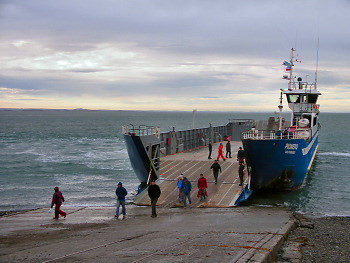
Punta Delgada ferry at the First Narrows of the Strait of Magellan
The attitudes of the crew of the Beagle to the traditional peoples which they met in distant parts of the World were often confusing and contradictory. On one hand, they looked down on them with scorn, often calling them "savages," or comparing them to "wild beasts" who obviously had suffered so much by not being "lucky" enough to have been born in the emerging industrial World. On the other hand, when they dealt with them on a personal level, more often than not their comments reflected their new acquaintances good humor, selflessness, and cleverness. Nothing better illustrates this point than the crew's observations and personal dealing with the Yamana people of the island of Tierra del Fuego. That tribe, resident there for possibly millennia, lived in a rather atypical societal structure, adopting a completely maritime existence and spending almost all of their time on canoes navigating the labyrinth of channels and islands of the region. That mode of living had obviously worked for them for a great length of time, but the visitors from the northern hemisphere could still not see any merit in their existence.
Mr. C. R. Darwin:"At a subsequent period the Beagle anchored for a couple of days under Wollaston Island, which is a short way to the northward. While going on shore we pulled alongside a canoe with six Fuegians. These were the most abject and miserable creatures I any where beheld. On the east coast the natives, as we have seen, have guanaco cloaks, and on the west, they possess seal-skins. Amongst these central tribes the men generally possess an otter-skin, or some small scrap about as large as a pocket-handkerchief, which is barely sufficient to cover their backs as low down as their loins. It is laced across the breast by strings, and according as the wind blows, it is shifted from side to side. But these Fuegians in the canoe were quite naked, and even one full-grown woman was absolutely so. It was raining heavily, and the fresh water, together with the spray, trickled down her body. In another harbour not far distant, a woman, who was suckling a recently-born child, came one day alongside the vessel, and remained there whilst the sleet fell and thawed on her naked bosom, and on the skin of her naked child. These poor wretches were stunted in their growth, their hideous faces bedaubed with white paint, their skins filthy and greasy, their hair entangled, their voices discordant, their gestures violent and without dignity. Viewing such men, one can hardly make oneself believe they are fellow-creatures, and inhabitants of the same world. It is a common subject of conjecture what pleasure in life some of the less gifted animals can enjoy: how much more reasonably the same question may be asked with respect to these barbarians. At night, five or six human beings, naked and scarcely protected from the wind and rain of this tempestuous climate, sleep on the wet ground coiled up like animals. Whenever it is low water, they must rise to pick shell-fish from the rocks; and the women, winter and summer, either dive to collect sea eggs, or sit patiently in their canoes, and, with a baited hair-line, jerk out small fish. If a seal is killed, or the floating carcass of a putrid whale discovered, it is a feast: such miserable food is assisted by a few tasteless berries and fungi. Nor are they exempt from famine, and, as a consequence, cannibalism accompanied by parricide."
In one of the more unique aspects of the Beagle story, four Yamana people were, in effect, kidnapped by Fitz-Roy during the first voyage and brought back to England with him. To his credit, he had been making plans to fund his own expedition to return them home, when the Beagle was commissioned for a second voyage. Of course, Darwin can continue this story better than I can:
Mr. C. R. Darwin:
"I have not as yet noticed the Fuegians whom we had on board. During the former voyage of the Adventure and Beagle in 1826 to 1830, Captain Fitz Roy seized on a party of natives, as hostages for the loss of a boat, which had been stolen, to the great jeopardy of a party employed on the survey; and some of these natives, as well as a child whom he bought for a pearl-button, he took with him to England, determining to educate them and instruct them in religion at his own expense. To settle these natives in their own country, was one chief inducement to Captain Fitz Roy to undertake our present voyage; and before the Admiralty had resolved to send out this expedition, Captain Fitz Roy had generously chartered a vessel, and would himself have taken them back. The natives were accompanied by a missionary, R. Matthews; of whom and of the natives, Captain Fitz Roy has published a full and excellent account. Two men, one of whom died in England of the small-pox, a boy and a little girl, were originally taken; and we had now on board, York Minster, Jemmy Button (whose name expresses his purchasemoney), and Fuegia Basket. York Minster was a full-grown, short, thick, powerful man: his disposition was reserved, taciturn, morose, and when excited violently passionate; his affections were very strong towards a few friends on board; his intellect good. Jemmy Button was a universal favourite, but likewise passionate; the expression of his face at once showed his nice disposition. He was merry and often laughed, and was remarkably sympathetic with any one in pain: when the water was rough, I was often a little sea-sick, and he used to come to me and say in a plaintive voice, "Poor, poor fellow!" but the notion, after his aquatic life, of a man being sea-sick, was too ludicrous, and he was generally obliged to turn on one side to hide a smile or laugh, and then he would repeat his "Poor, poor fellow!" He was of a patriotic disposition; and he liked to praise his own tribe and country, in which he truly said there were "plenty of trees," and he abused all the other tribes: he stoutly declared that there was no Devil in his land. Jemmy was short, thick, and fat, but vain of his personal appearance; he used always to wear gloves, his hair was neatly cut, and he was distressed if his well-polished shoes were dirtied. He was fond of admiring himself in a looking-glass; and a merry-faced little Indian boy from the Rio Negro, whom we had for some months on board, soon perceived this, and used to mock him: Jemmy, who was always rather jealous of the attention paid to this little boy, did not at all like this, and used to say, with rather a contemptuous twist of his head, "Too much skylark." It seems yet wonderful to me, when I think over all his many good qualities, that he should have been of the same race, and doubtless partaken of the same character, with the miserable, degraded savages whom we first met here. Lastly, Fuegia Basket was a nice, modest, reserved young girl, with a rather pleasing but sometimes sullen expression, and very quick in learning anything, especially languages. This she showed in picking up some Portuguese and Spanish, when left on shore for only a short time at Rio de Janeiro and Monte Video, and in her knowledge of English. York Minster was very jealous of any attention paid to her; for it was clear he determined to marry her as soon as they were settled on shore."
When I visited the area during Stage 4, there was only one entirely Yamana person left alive, and elderly woman, who had recently moved to the "big town" of Puerto Williams on Isla Navarino, the southernmost town in the World, home to a few hundred residents who support the nearby Chilean Naval base. The rest of the descendents of the Yamana live in a little cluster of homes just outside of town called Ukika, having long since abandoned their canoes.
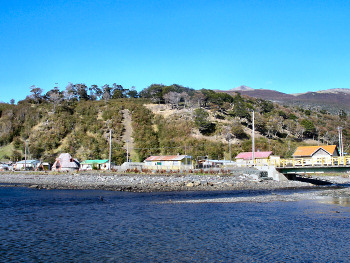
Ukika, the last indigenous Yamana community
To avoid a long, duplicate ride back north over Tierra del Fuego, I instead took the weekly ferry that runs from Isla Navarino to the region's major city, Punta Arenas, which, of course, had not existed when the Beagle explored the region. In addition to a getting a little extra rest that way, I was treated to a spectacular, if spartan, cruise through the incredible scenery of the waterways of the region. Chief among those was the Canal Beagle, named after the ship that is the hero of our story, and an exquisite example of a sub-Antarctic waterway, lined with snow-capped mountains and hanging glaciers. To my good fortune, for once, the weather cooperated as well, affording me many spectacular views. Isla Gordon, mentioned by Darwin below, was the point where the channel divided into two branches. The ferry took the same path that the Beagle had previously sailed.
Mr. C. R. Darwin:"Early in the morning we arrived at the point where the Beagle channel divides itself into two arms; and we entered the northern one. The scenery here becomes even grander than before. The lofty mountains on the north side compose the granitic axis, or backbone of the whole country. They were covered by a wide mantle of perpetual snow, and numerous cascades poured their waters, through the woods, into the narrow channel below. In many parts magnificent glaciers extended from the mountain side to the water's edge. It is scarcely possible to imagine any thing more beautiful than the beryl-like blue of the glacier, and especially when contrasted with the dead white of an expanse of snow. As fragments fell from the glacier into the water, they floated away, and the channel with its icebergs represented in miniature the polar sea. When we reached the western mouth of this branch of the channel, we sailed amongst many unknown islands, and then proceeded by the outer coast to the entrance of the other arm. Thence we returned to Ponsonby Sound, saw the Fuegians, and arrived at the ship after our twenty-days' excursion."
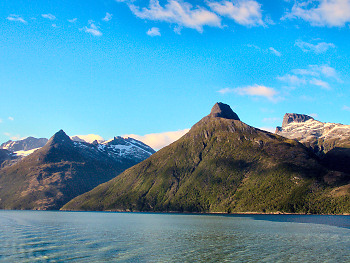
Isla Gordon, at the fork in the Canal Beagle
An even more impressive, not to mention relevant,
sight was the beautiful range known as the Cordillera Darwin. Named after one of our
protagonists, the range is certainly befitting a person of his stature,
and naming it for him must have made him quite grateful, as he seemed to
have a definite affinity for tall mountains. 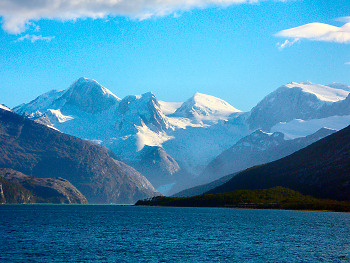
The Cordillera Darwin, alongside the Canal Beagle
While in the region, the crew of the second voyage made an excursion up the nearby Rio Santa Cruz, at the southern tip of Patagonia, possibly to determine if there was any merit to using it as part of a route across the Andes. They, in fact, did not quite reach the great range, but came fairly close. Their impressions of the surrounding countryside were not especially favorable, which is probably not surprising considering they were accomplished mariners out of their element, crossing a dry, cold, windswept plain. I crossed the same river in two locations, one near its mouth, and one close to its source in Lago Argentina. While I perhaps found the scenery a little more appealing, I certainly can understand the longing for greener environs, which that region often inspires.
Capt. R. Fitz-Roy:"Early on the 18th we left the Beagle, and with a favouring wind and flood tide sailed up the estuary, into which the river flows. This wide and turbid estuary receives a torrent which rushes through a confined opening into the ocean, during seven hours, and is opposed and driven back by the flood tide during about five hours of the twelve. On each side of both the estuary and river lie extensive plains of arid desert land: these plains are not, however, on the same level; for, on the northern bank the land is very little raised above the level of high spring tides; while, on the southern side of the river, high, perpendicular cliffs form a striking contrast: but after ascending these heights, by any of the ravines which intersect them, one finds a dead level expanse, similar in every respect to that on the northern shore. In the horizon, another 'steppe,' or parallel plain, at a higher elevation, is seen; which, at a distance, appears like a range of hills of equal height."Mr. C. R. Darwin:
"The country remained the same, and was extremely uninteresting. The complete similarity of the productions throughout Patagonia, is one of its most striking characters. The level plains of arid shingle support the same stunted and dwarf plants; and in the valleys the same thorn-bearing bushes grow. Every where we see the same birds and insects. Even the very banks of the river, and of the clear streamlets which entered it, were scarcely enlivened by a brighter tint of green. The curse of sterility is on the land, and the water flowing over a bed of pebbles partakes of the same curse. Hence the number of waterfowl is very scanty; for what is there to support life in the stream of this barren river?"
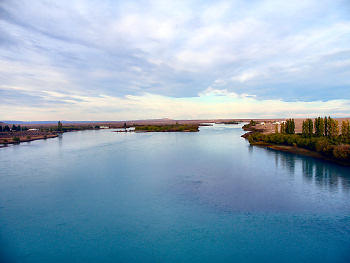
The Rio Santa Cruz, near its mouth
Capt. R. Fitz-Roy:
"In the distant west the Cordillera of the Andes stretched along the horizon. During three days, we had advanced towards those far distant mountains, seeing them at times very distinctly; yet this morning our distance seemed nearly as great as on the day we first saw their snow-covered summits. A long day's work carried us beyond the flat and into the rising country, whose barren appearance I just now mentioned. We were all very tired of the monotonous scene, as well as of the labour of hauling the boats along."Mr. C. R. Darwin:
"Captain FitzRoy determined to take the boats no higher. The river had a winding course, and was very rapid; and the appearance of the country offered no temptation to proceed any further. Every where we met with the same productions, and the same dreary landscape. We were now one hundred and forty miles distant from the Atlantic, and about sixty from the nearest arm of the Pacific. The valley in this upper part expanded into a wide basin, bounded on the north and south by the basaltic platforms, and fronted by the long range of the snow-clad Cordillera. But we viewed these grand mountains with regret, for we were obliged to imagine their form and nature, instead of standing, as we had hoped, on their crest, and looking down on the plain below."
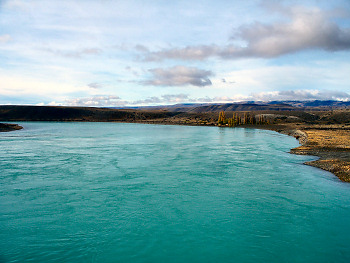
The Rio Santa Cruz, near its source
After both the Beagle and I had spent long, and often difficult, periods at the southern tip of the continent, out next encounters came on the Pacific coast, most of which is occupied by the long narrow, nation of Chile. Specifically, at the island of Chiloe, which has an interesting history, often existing as an isolated enclave of colonial society. That forced the residents there to develop their own unique culture, complete with vivid mythologies, and an exceptional collection of wooden churches. Darwin seemed most impressed by the weather, which must have been just slightly better when I visited, though, thanks to the persistent clouds, I never did see most of the region's volcanoes.
Mr. C. R. Darwin:"This island is about ninety miles long, with a breadth of rather less than thirty. The land is hilly, but not mountainous, and is every where covered by one great forest, excepting a few scattered green patches, which have been cleared round the thatched cottages. From a distance the view somewhat resembles Tierra del Fuego; but the woods, when seen nearer, are incomparably more beautiful. Many kinds of fine evergreen trees, and plants with a tropical character, here take the place of the gloomy beech of the southern shores. In winter the climate is detestable, and in summer it is only a little better. I should think there are few parts of the world, within the temperate regions, where so much rain falls. The winds are very boisterous, and the sky almost always clouded: to have a week of fine weather is something wonderful. It is even difficult to get a single glimpse of the Cordillera: during our first visit only one opportunity occurred, and that was before sunrise, when the Volcano of Osorno stood out in bold relief; and it was curious to watch, as the sun rose, the outline gradually fading away in the glare of the eastern sky.""Early on Sunday morning we reached Castro,—the ancient capital of Chiloe, but now a most forlorn and deserted place. The usual quadrangular arrangement of Spanish towns could be traced, but the streets and plaza were coated with fine green turf, on which sheep were browsing. The church, which stands in the middle, is entirely built of plank, and has a picturesque and venerable appearance. The poverty of the place may be conceived from the fact, that although containing some hundreds of inhabitants, one of our party was unable any where to purchase either a pound of sugar, or an ordinary knife. No individual possessed either a watch or a clock; and an old man, who was supposed to have a good idea of time, was employed to strike the church bell by guess."
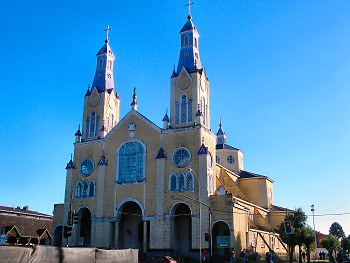
Iglesia San Francisco de Castro, Isla Chiloe, Chile
Farther up the coast, we next shared sights again at Valdivia, a modest coastal town, though my time there was less eventful than the Beagle crew's had been. I found Valdivia to be a rather unremarkable town, pleasant, but with little to distinguish it from others. Of course, it was quite a bit less impressive by its own right when the ship visited, but proved to be one of the most memorable places of their voyages, thanks to the effects of a major earthquake.
[Note: One hundred twenty-five years later, another massive earthquake struck near Valdivia. That tremor reached an astounding magnitude 9.5, and is currently the strongest such event known since intensity measurements have been possible.]
Capt. R. Fitz-Roy:"The town of Valdivia, formerly dignified by the appellation of city, disappointed our party extremely. It proved to be no more than a straggling village of wooden houses, surrounded with apple-trees; and the only building, even partially constructed of stone, was a church. Many of us were in the town on the 20th of February, at the time of that great earthquake, which ruined so many places besides the city of Concepcion: an awful event, which will be related in the following pages."Mr. C. R. Darwin:
"The day has been memorable in the annals of Valdivia, for the most severe earthquake experienced by the oldest inhabitant. I happened to be on shore, and was lying down in the wood to rest myself. It came on suddenly, and lasted two minutes; but the time appearedmuch longer. The rocking of the ground was most sensible. The undulations appeared to my companion and myself to come from due east; whilst others thought they proceeded from south-west; which shows how difficult it is in all cases to perceive the direction of these vibrations. There was no difficulty in standing upright, but the motion made me almost giddy. It was something like the movement of a vessel in a little cross ripple, or still more like that felt by a person skating over thin ice, which bends under the weight of his body.A bad earthquake at once destroys the oldest associations: the world, the very emblem of all that is solid, has moved beneath our feet like a crust over a fluid;—one second of time has conveyed to the mind a strange idea of insecurity, which hours of reflection would never have created. In the forest, as a breeze moved the trees, I only felt the earth tremble, but saw no consequences from it. Captain FitzRoy and the officers were at the town during the shock, and there the scene was more awful; for although the houses, from being built of wood, did not fall, yet they were so violently shaken that the boards creaked and rattled. The people rushed out of doors in the greatest alarm. I feel little doubt that it is these accompaniments which cause that horror of earthquakes, experienced by all those who have thus seen as well as felt their effects."
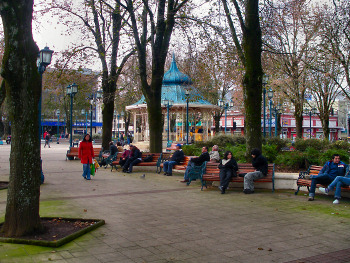
Valdivia, Chile
It was Concepcion, my next stop that took the brunt of the tremor, however. The details were vividly recalled by the Beagle crew, and the event certainly made an impact on their perceptions, especially Darwin's.
Capt. R. Fitz-Roy:"This fatal convulsion took place about a minute and a half or two minutes after the first shock; and it lasted for nearly two minutes, with equal violence. During this time no one could stand unsupported; people clung to each other, to trees, or to posts. Some threw themselves on the ground; but there the motion was so violent that they were obliged to stretch out their arms on each side, to prevent being tossed over and over. The poultry flew about screaming wildly. Horses and other animals were greatly frightened, standing with their legs spread out, and their heads down, trembling excessively.Mr. C. R. Darwin:After the most violent shock ceased, the clouds of dust which had been raised by falling buildings, began to disperse; people breathed more freely, and dared to look around them. Ghastly and sepulchral was the sight. Had the graves opened and given up their dead, their appearance could scarcely have been more shocking. Pale and trembling, covered with dust and perspiration, they ran from place to place, calling for relations and friends; and many seemed to be quite bereft of reason.
Considerable shocks continued to harass and alarm at short intervals. The earth was never long quiet during that or the next day, nor indeed for the three days following the great shock; and during many hours after the ruin, it was tremulous, and the shocks were very frequent, though not severe. Many of these, but not all, were preceded by a rumbling, subterranean noise, like distant thunder. Some compared the sound to the distant discharge of many pieces of artillery. These noises came from the south-west quarter, and preceded the shock by one or two seconds; sometimes, but not often, the sound was unaccompanied by any shock."
"We sailed from Valdivia, and on the 4th of March, entered the harbour of Concepcion. While the ship was beating up to the anchorage, which is distant several miles, I was landed on the island of Quiriquina. The mayor-domo of the estate quickly rode down to tell us the terrible news of the great earthquake of the 20th;—"that not a house in Concepcion, or Talcuhano, (the port) was standing; that seventy villages were destroyed; and that a great wave had almost washed away the ruins of Talcuhano." Of this latter fact I soon saw abundant proof: the whole coast being strewed over with timber and furniture, as if a thousand great ships had been wrecked. Besides chairs, tables, bookshelves, &c., in great numbers, there were several roofs of cottages, which had been drifted in an almost entire state. The storehouses at Talcuhano had burst open, and great bags of cotton, yerba, and other valuable merchandise, were scattered about on the shore. During my walk round the island, I observed that numerous fragments of rock, which, from the marine productions adhering to them, must recently have been lying in deep water, had been cast up high on the beach. One of these was a slab six feet by three, and about two feet thick.""I have not attempted to give any detailed description of the appearance of Concepcion, for I feel it is quite impossible to convey the mingled feelings with which one beholds such a spectacle. Several of the officers visited it before me, but their strongest language failed to communicate a just idea of the desolation. It is a bitter and humiliating thing to see works, which have cost men so much time and labour, overthrown in one minute; yet compassion for the inhabitants is almost instantly forgotten, from the interest excited in finding that state of things produced in a moment of time, which one is accustomed to attribute to a succession of ages. In my opinion, we have scarcely beheld since leaving England, any other sight so deeply interesting."
"The different resistance offered by the walls, according to their direction, was well exemplified in the case of the cathedral. The side which fronted the N.E. presented a grand pile of ruins, in the midst of which door-cases and masses of timber stood up, as if floating in a stream. Some of the angular blocks of brickwork were of great dimensions; and they had been rolled to a distance on the level plaza, like fragments of rock round the base of some high mountain. The side walls, though exceedingly fractured, yet remained standing; but the vast buttresses (at right angles to them, and therefore parallel to the walls that fell) were in many cases cut clean off, as if by a chisel, and hurled to the ground."
Coincidentally, a very major quake also struck the Pacific coast of South America during my Tour, though it would be three months before I saw the results. That event occured at the Peruvian coastal town of Pisco, and even at the late date that I arrived, I could see that the damage had been just as severe as what the Beagle crew witnessed.
Back at Concepcion, the city today reveals little
to casual observers of the fact that it has been destroyed at least three
times over the years by tectonic activity. In Fitz-Roy's account, an
engraving depicting the collapsed Cathedral of Concepcion testifies to the
magnitude of the disaster. What is not revealed is that its replacement
met a similar fate in 01939 at the hands of an even more devastating
tremor. The cathedral that I observed in Concepcion when I visited appears
notably less elaborate and a little dour, compared to other examples on
the continent. That is due to its third incarnation being constructed with
was has been assumed to be "earthquake-proof" methods and materials. Time
will tell.
[Note: Time did tell. Three years after I was in Concepcion, in the early morning of Febraury 27, 02010, another major earthquake struck near the city. That tremor possessed a magnitude 8.8. The Catherdal apparently did survive without major damage, but many other buildings were not so fortunate, and there was also considerable loss of life.]
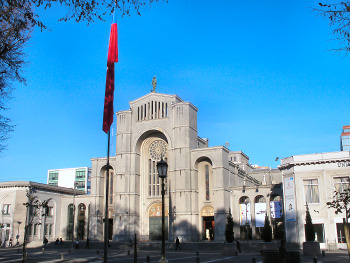
Concepcion Cathedral
Continuing to the north, I next crossed paths with Darwin as he undertook a few more land-based excursions, seeking to satisfy his desire to experience the mountains. Both of us spent a relatively long while in Santiago, the capital of Chile, but for different reasons. Darwin stayed there as he was in no particular hurry thanks to the schedule of the Beagle. I, on the other hand, was laid up for over a week with a tenacious head cold, my only such malady experienced during the Tour. The city today certainly would not be recognized by Darwin were he to see it now.
Mr. C. R. Darwin:"I staid a week in Santiago, and enjoyed myself very much. In the morning I rode to various places on the plain, and in the evening dined with several of the English merchants, whose hospitality at this place is well known. A never-failing source of pleasure, was to ascend the little pap of rock (fort St. Lucia) which projects in the middle of the city. The scenery certainly is most striking, and as I have said, very peculiar. I am informed that this same character is common to the cities on the great Mexican platform. Of the town I have nothing to say in detail: it is not so fine or so large as Buenos Ayres, but is built after the same model."
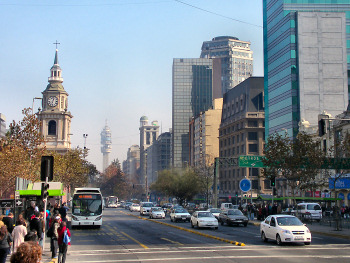
Downtown Santiago, Chile
The Beagle's initial stop on the west coast was Valparaiso, which was made before the ship explored the southern coast and Chiloe. I was still not feeling back to normal when I arrived, but I was still able to appreciate the views of the city, which do not seem to have changed that much from those seen by Darwin, though multicolored homes have apparently replaced the plain white type of that earlier time.
Mr. C. R. Darwin:"The Beagle anchored late at night in the bay of Valparaiso, the chief seaport of Chile. When morning came, every thing appeared delightful. After Tierra del Fuego, the climate felt quite delicious—the atmosphere so dry, and the heavens so clear and blue, with the sun shining brightly, that all nature seemed sparkling with life. The view from the anchorage is very pretty. The town is built at the very foot of a range of hills, about 1600 feet high, and rather steep. From its position, it consists of one long, straggling street, which runs parallel to the beach, and wherever a ravine comes down, the houses are piled up on each side of it. The rounded hills, being only partially protected by a very scanty vegetation, are worn into numberless little gullies, which expose a singularly bright red soil. From this cause, and from the low whitewashed houses with tile roofs, the view reminded me of St. Cruz in Teneriffe."
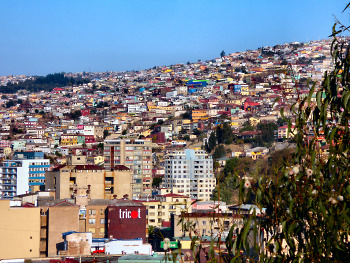
Hillside homes in Valparaiso, Chile
Darwin's mountain trek proved to be a little confusing when it came time to compare our routes. He crossed the Andes twice, first to the south of Santiago, at a pass called Portillo and then returned from Argentina father north at a pass he called Uspallata, the name of an Argentine town near its base. The latter pass is the major crossing of the Andes today, now know as the Paso Libertadores. There is currently no pass in the area that Darwin first crossed called Portillo, and no roads that even lead to the general vicinity of his route. There is, however, a ski resort on the Chilean sine of the summit of Paso Libertadores named Portillo, where I spent the night after a long climb, and I had to read Darwin's account carefully to be sure we actually crossed at the same place.
We, in fact, did both cross Paso Libertadores, but in opposite directions. Our opinions of the scenery on either side were also divergent. Darwin seemed to prefer the Chilean side, though even there he did not find it completely to his liking, whereas I found the drier, sunnier Argentine side much more appealing.
Mr. C. R. Darwin:"The scenery in this part had assumed a Chilian character: the lower parts of the mountains, dotted over with the pale evergreen Quillay tree, and with the great candlestick cactus, certainly are more to be admired than any thing in the bare Eastern valleys; but I cannot quite agree with the admiration expressed by some travellers. The extreme pleasure, I suspect, is chiefly owing to the prospect of a good fire, after escaping from the cold regions above: and I am sure I most heartily participated in such feelings."
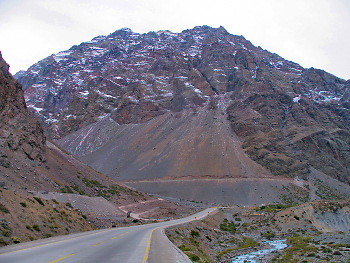
The west side of the Andes, near Portillo resort, Chile
Mr. C. R. Darwin:
"The scenery thus far was very uninteresting, compared with that of the Portillo pass. Little can be seen beyond the bare walls of the one grand, flat-bottomed valley, which the road follows up to the highest crest. The valley and the huge rocky mountains were extremely barren: during the two previous nights the poor mules had absolutely nothing to eat; for excepting a few low resinous bushes, scarcely a plant could be seen."
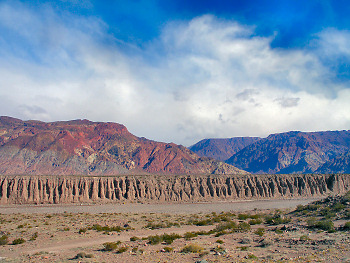
The east side of the Andes, near Uspallata, Argentina
Once again, traveling in opposite direction on the same route, we each passed through the little town of Lujan de Cuyo. I, however, was anxious to reach the major city of Mendoza, and so rode straight through without stopping. Darwin, on the other hand, spent at least one night in that small town. That may have been to my good fortune, as the following passage reveals:
Mr. C. R. Darwin:"We crossed the Luxan, which is a river of considerable size, though its course towards the sea-coast is very imperfectly known. It is even doubtful whether, in passing over the plains, it is evaporated, or whether it forms a tributary of the Sauce or Colorado. We slept in the village, which is a small place surrounded by gardens, and forms the most southern part, that is cultivated, of the province of Mendoza; it is five leagues south of the capital. At night I experienced an attack (for it deserves no less a name) of the Benchuca (a species of Reduvius) the great black bug of the Pampas. It is most disgusting to feel soft wingless insects, about an inch long, crawling over one's body. Before sucking they are quite thin, but afterwards become round and bloated with blood, and in this state they are easily crushed. They are also found in the northern parts of Chile and in Peru. One which I caught at Iquique was very empty. When placed on the table, and though surrounded by people, if a finger was presented, the bold insect would immediately draw its sucker, make a charge, and if allowed, draw blood. No pain was caused by the wound. It was curious to watch its body during the act of sucking, as it changed in less than ten minutes, from being as flat as a wafer to a globular form. This one feast, for which the benchuca was indebted to one of the officers, kept it fat during four whole months; but, after the first fortnight, the insect was quite ready to have another suck."
It has been speculated that the bite of the
Benchuca gave Darwin Chagas Disease, a
parasitic infection spread almost exclusively by that particular insect.
Darwin was said to be in ill health for much of his latter life, including
episodes of heart trouble, a known symptom of Chagas. Though he lived to a
respectable age of 73, his poor health may have slowed the progress of his
writings and his later investigations. We can be grateful that he managed
to publish his major works despite this setback. I am also grateful that a
Benchuca never found its way into my tent at night.
Mr.
C. R. Darwin:
"We rode on to Mendoza. The country was beautifully cultivated, and resembled Chile. This neighbourhood is celebrated for its fruit; and certainly nothing could appear more flourishing than the vineyards and the orchards of figs, peaches, and olives. We bought watermelons nearly twice as large as a man's head, most deliciously cool and well-flavoured, for a halfpenny apiece; and for the value of threepence, half a wheelbarrowful of peaches. The cultivated and enclosed part of this province is very small; there is little more than that which we passed through between Luxan and the capital. The land, as in Chile, entirely owes its fertility to artificial irrigation; and it is really wonderful to observe how abundantly productive a barren traversia is rendered by this simple process."
The Mendoza area is still famous for its
vineyards, and I enjoyed their presence, as much for the typically good
cycling conditions that are often found wherever that product is
cultivated, as for the beverage their grapes produce.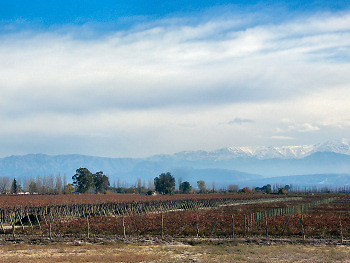
Vineyards and distant Andes, near Mendoza
My route then crossed over to the Atlantic coast
of the continent, and a number of places I visited there were also called
by the Beagle, though in the early stages of
its voyages. One such case involved another of Darwin's excursions away
from the ship, specifically his trek up the Rio Parana to Santa Fe. I also
encountered that river, on numerous occasions, and I found it to be among
the most massive of the rivers I have seen. My experiences were a little
less appealing than Darwin's were, however. He eventually managed to see
quite a bit of wildlife in the area, and noted its lush vegetation. When I
was there, that area was largely agricultural and heavily populated.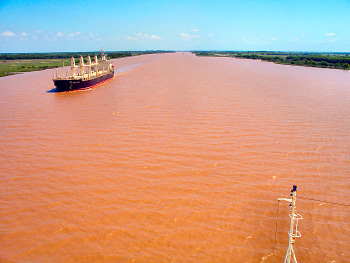
The Rio Parana, near its mouth
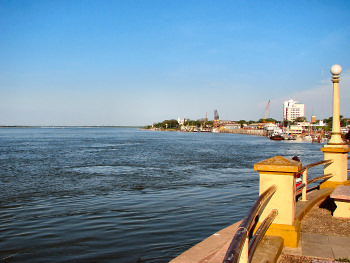
The Rio Parana, at Corrientes, Argentina
Mr. C. R. Darwin:
"I was confined to my bed by a headache for these two days. A goodnatured old woman, who attended me, wished me to try many odd remedies. A common practice is, to bind an orange-leaf, or a bit of black plaster, to each temple; and a still more general plan is, to split a bean into halves, moisten them, and place one on each temple, where they will easily adhere. It is not thought proper ever to remove the beans or plaster, but to allow them to drop off; and sometimes, if a man, with patches on his head, is asked, what is the matter? he will answer, "I had a headache the day before yesterday.""St. Fe is a quiet little town, and is kept clean, and in good order. The governor, Lopez, was a common soldier at the time of the revolution; but has now been seventeen years in power. This stability of government is owing to his tyrannical habits; for tyranny seems as yet better adapted to these countries, than republicanism. The governor's favourite occupation is hunting Indians: a short time since he slaughtered forty-eight, and sold the children at the rate of three or four pounds apiece."
"We crossed the Parana to St. Fe Bajada, a town on the opposite shore. The passage took some hours, as the river here consisted of a labyrinth of small streams, separated by low wooded islands. I had a letter of introduction to an old Catalonian Spaniard, who treated me with the most uncommon hospitality. The Bajada is the capital of Entre Rios. In 1825 the town contained 6000 inhabitants, and the province 30,000; yet, few as they are, none have suffered more from bloody and desperate revolutions. They boast here of representatives, ministers, a standing army, and governors: so it is no wonder that they have their revolutions. At some future day this must be one of the richest countries of La Plata. The soil is varied and productive, and its almost insular form gives it two grand lines of communication by the rivers Parana and Uruguay."
Both Santa Fe and its neighbor across the river,
Parana, formerly Santa Fe Bajada, are now major regional cities. I was
feeling rather worn out while I was there, partially due to a few months
in the cold of Patagonia and the Andes, but more so as a result of a few
days of incredibly stressful traffic in the vicinity. Consequently, I did
not see very much of interest in the area, though I found Parana to be a
somewhat more agreeable town than its older neighbor. 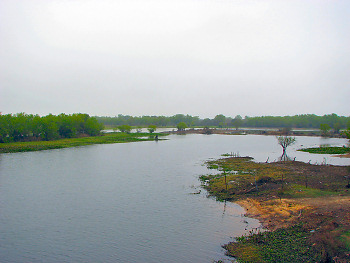
A minor channel of the Rio Parana, near Santa Fe, Argentina
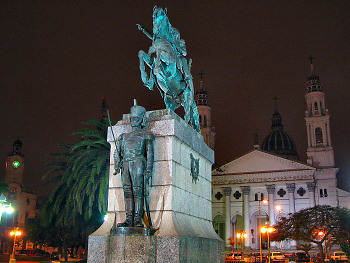
Plaza San Martin, Parana, Argentina
Shortly after, I entered Uruguay, by crossing yet another major river, the namesake of that country. While it was noticeably smaller than the Parana, I agreed with Darwin's assessment of its aesthetic qualities, though I saw no Jaguar tracks.
Mr. C. R. Darwin:"In the morning we rode to a projecting headland on the banks of the river, called Punta Gorda. On the way we tried to find a jaguar. There were plenty of fresh tracks, and we visited the trees, on which they are said to sharpen their claws; but we did not succeed in disturbing one. From this point the Rio Uruguay presented to our view a noble volume of water. From the clearness and rapidity of the stream, its appearance was far superior to that of its neighbour the Parana."
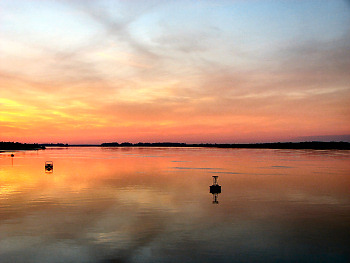
The Rio Uruguay at Paysandu, Uruguay
I overlaid yet another of Darwin's land excursions when I rode to Colonia del Sacramento on the shores of the Rio de la Plata. It is an historic town, whose zenith of importance came during the war between Argentina and Brazil that lead to Uruguay's independence. When Darwin arrived that conflict was not long over, and signs of is destructive consequences were apparent all around. In my time, Colonia is a relaxing tourist destination, popular with residents of Buenos Aires.
Mr. C. R. Darwin:"The town is built on a stony promontory something in the same manner as at Monte Video. It is strongly fortified; but both fortifications and town suffered much from the Brazilian war. It is very ancient; and the irregularity of the streets, and the surrounding groves of old orange and peach trees gave it a pretty appearance. The church is a curious ruin; it was used as a powder-magazine, and was struck by lightning in one of the ten thousand thunderstorms of the Rio Plata. Two-thirds of the building were blown away to the very foundation; and the rest stands a shattered and curious monument, of the united powers of lightning and gunpowder. In the evening I wandered about the half-demolished walls of the town. It was the chief seat of the Brazilian war;—a war most injurious to this country, not so much in its immediate effects, as in being the origin of a multitude of generals and all other grades of officers. More generals are numbered (but not paid) in the United Provinces of la Plata, than in the United Kingdom of Great Britain. These gentlemen have learned to like power, and do not object to a little skirmishing. Hence there are many, always on the watch to create disturbance and to overturn a government, which as yet has never rested on any stable foundation."
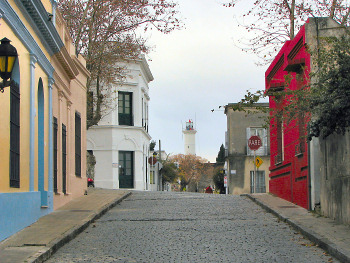
Street and Lighthouse in Colonia del Sacramento, Uruguay
While in Colonia, I was pleased to see an excellent display of fossils in the local museum. One that stood out, was a giant Glyptodont shell, once the armor-like plating of a large herbivore. Darwin collected may impressive fossils on his journey, including Glyptodont shells and other examples of extinct megafauna. They certainly made quite an impression on him, and raised many important questions relating to extinctions. These must have been central to the development of his theory of natural selection. I often wish, however, that I could have seen South America thousands of years earlier, while its great creatures still roamed the plains.
Mr. C. R. Darwin:"At the distance of a few leagues I visited a place where the remains of another great animal, associated with large pieces of armadillo-like covering, had been found. Similar pieces were likewise lying in the bed of the stream, close to the spot where the skeleton of the Toxodon had been exposed. These portions are dissimilar from those mentioned at Bahia Blanca. It is a most interesting fact thus to discover, that more than one gigantic animal in former ages was protected by a coat of mail, very similar to the kind now found on the numerous species of armadillo, and exclusively confined to that South-American genus."
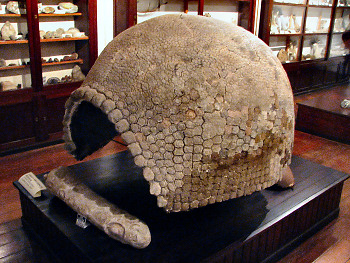
A fossilized Glyptodont Shell at the Colonia Museum
The Beagle called at Montevideo many times. The busy seaport and capital must not have made much of an impression on the crew, as apart from Fitz-Roy describing his loan of a detachment of troops to assist in putting down a slave rebellion in the city, little mention is made of the city or its people in the accounts of the voyages. I also found Montevideo to be a little unremarkable, relative to other major capitals of the World, but I, nevertheless, spent a nice few days there.
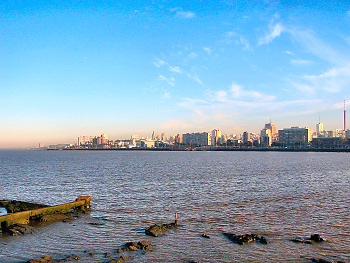
Montevideo Uruguay, and the Rio de la Plata
Mr. C. R. Darwin:
"Maldonado is situated on the northern bank of the Plata, and not very far from the mouth of the estuary. It is a most quiet, forlorn, little town; built, as is universally the case in these countries, with the streets running at right angles to each other, and having in the middle a large plaza or square, which, from its size, renders the scantiness of the population more evident and more unsociable. It possesses scarcely any trade; the exports being confined to a few hides and living cattle. The inhabitants are chiefly landowners, together with a few shopkeepers and the necessary tradesmen, such as blacksmiths and carpenters, who do nearly all the business for a circuit of fifty miles round."
I agreed with Darwin's description of Maldonado as
a quiet place, but not with his rather dismissive comments about its
relevance. For me, a quiet little town in which to rest for a night is
always appreciated. The cathedral shown below was present when Darwin
visited the town.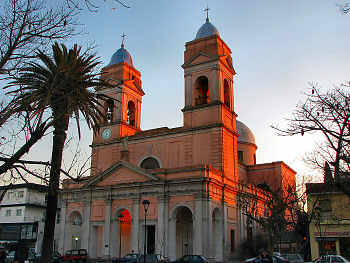
The Cathedral at Maldonado, Uruguay
I also agreed with the descriptions given about Rio de Janeiro, the first place on the east coast of the continent that the Beagle visited, but the last on that same coast which I did. It certainly retains its status as having one of the most beautiful geographic locations of any city in the World. While the urban realm of the city has exploded outwards and upward since the Beagle visited, that has not really diminished the aesthetics of the place. In fact, the ability to easily take in the views from atop the Corcovado and Pao de Acucar gives modern visitors somewhat of an edge over those from the Beagle's era.
Capt. R. Fitz-Roy:"Soon after mid-day black curling ripples stole along the hitherto glassy surface; sail was made, the sea-breeze freshened, and we steered towards the entrance of that magnificent harbour, Rio de Janeiro.Mr. C. R. Darwin:Often as it has been visited and described, I cannot expect any one to require another sketch, but will merely remark that I know no port equal to it in situation, security, capacity, convenience, and abundant supply of every necessary, as well as in picturesque beauty."
"Every one has heard of the beauty of the scenery near Botofogo. The house in which I lived was seated close beneath the well-known mountain of the Corcovado. It has been remarked, with much truth, that abruptly conical hills are characteristic of the formation which Humboldt designates as gneiss-granite. Nothing can be more striking than the effect of these huge rounded masses of naked rock rising out of the most luxuriant vegetation.""This is the only butterfly which I have ever seen that uses its legs for running. Not being aware of this fact, the insect, more than once, as I cautiously approached with my forceps, shuffled on one side just as the instrument was on the point of closing, and thus escaped. But a far more singular fact, is the power which this species possesses of making a noise. Several times when a pair, probably male and female, were chasing each other in an irregular course, they passed within a few yards of me; and I distinctly heard a clicking noise, similar to that produced by a toothed wheel passing under a spring catch. The noise was continued at short intervals, and could be distinguished at about twenty yards distance. I cannot form a conjecture how it is produced; but I am certain there is no error in the observation."
I also encountered Darwin's noise-making
butterfly, though not until later, when I was in the Amazon basin. While
the environs around Rio are still rich in interesting creatures, in
general, the area must have been much more diverse and well stocked in
Darwin's time. 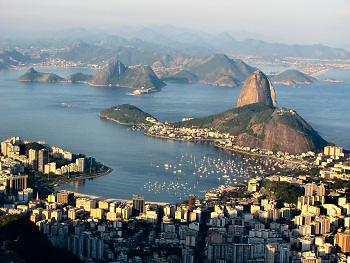
Rio de Janeiro
It was not until after a long ride through the interior of the continent, and then up and down through the Andes, that I caught up with the Beagle once again. That involved only one more stop on the mainland of South America, namely Callao, the port town of Lima, Peru. Lima is another example of a place that has exploded since the Beagle was there. These days, Lima is a mega-city, and Callao is a container terminal. I was warned against riding through Callao, due to its reputation for general wickedness, but I did so anyway as I had, by that time, become rather used to cycling in major ports. While I did not linger there any longer than necessary, that was long enough to confirm that area is still rather filthy, though I don't recall noticing any peculiar smells.
Mr. C. R. Darwin:"Callao is a filthy, ill-built, small seaport. The inhabitants, both there and at Lima, present every imaginable shade of mixture, between European, Negro, and Indian blood. They appear a depraved, drunken set of people. The atmosphere was loaded with foul smells, and that peculiar one, which may be perceived in almost every town within the tropics, was here very strong. The fortress, which withstood Lord Cochrane's long siege, has an imposing appearance. But the President, during our stay, sold the brass guns, and proceeded to dismantle parts of it. The reason assigned was, that he had not an officer to whom he could trust so important a charge. He himself had good reasons for knowing this, as he had obtained the presidentship by rebelling while in charge of this same fortress. After we left South America, he paid the penalty in the usual way, by being conquered, taken prisoner, and shot."
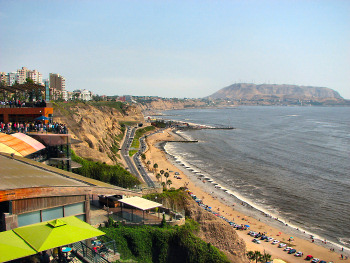
Pacific coast at Lima, Peru, just south of the port of Callao
Islas Galapagos
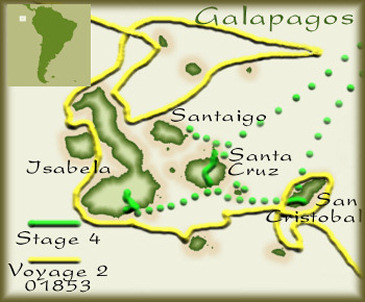
I had not intended to visit the Islas Galapagos during my Tour, however, once I realized that I had been following the Beagle for much of the way, I knew that I had to go. Though I tried mightily to arrange sea transport to the archipelago, that method of reaching the island is no longer permitted by the Ecuadorian government, unless one has their own seaworthy boat, that is. Instead, I arrived by air, at the main terminal on Isla Baltra, and then arranged day tours to the tourist sites on several nearby islands. That worked out well, but I certainly was envious of the Beagle crew's ability to survey the entire group and to go wherever they pleased. It is understandable that such wanderings are not permitted today, however, as the fragile ecosystem that has evolved there could not withstand much in the way of human interlopers.
In many ways, the islands are just as they were when the Beagle visited, each with its own collection of iguanas, tortoises, birds, and hardy plants, many of which are endemic to one or more of the islands. However, the human presence of the last two centuries, has also affected many changes on the isolated volcanic remnants. The handful of small towns found on four of the islands, some rather dubious efforts to establish agriculture there, and the presence of thousands of tourists annually, are today the most visible alterations. In earlier times, direct hunting of species such as the unique giant tortoises, led to their extinction of a few of the islands. Other changes that are less obvious may have proven to be more harmful still. For example, the goats and pigs that the Beagle crew observed around the human settlements of the time subsequently went feral on the islands where they were present, nearly wiping out their distinctive ecosystems. Efforts to exterminate the introduced species have helped restore the original communities, but that has not been an easy task.
Mr. C. R. Darwin:"The Beagle arrived at the southernmost of the Galapagos islands. This archipelago consists of ten principal islands, of which five much exceed the others in size. They are situated under the equatorial line, and between five and six hundred miles to the westward of the coast of America. The constitution of the whole is volcanic. With the exception of some ejected fragments of granite, which have been most curiously glazed and altered by the heat, every part consists of lava, or of sandstone resulting from the attrition of such materials."Capt. R. Fitz-Roy:
"In continuing our course, we passed through several ripplings, apparently caused by the meeting of streams of current which set along the shores of Chatham Island [Isla San Cristobal], from the east towards the west. If not so caused, they must be the effects of currents passing over very uneven ground, but we got no bottom, with fifty fathoms of line. When such appearances are created by shoals, it should be remembered that the shallowest place is generally under the smoothest part, close to the ripple. Favoured by smooth water and fine weather, we passed close to the low south-west extreme, and anchored directly that point was found to defend us from the swell.""...At a few yards from the water we found vegetation abundant, though the only soil seen was a little loose dusty earth, scattered upon and between the broken lava. Walking is extremely difficult. A hand-barrow was lying at the landing-place, which showed that terrapin were to be got near us, though we did not then see any. The men from whalers and sealing vessels carry the large terrapin, or land-tortoises, on these barrows.
Ascending a little hill, we were surprised to find much brush or underwood, and trees of considerable size, as large in the trunk as one man could clasp. These were prickly pears, and a kind of gum-tree: how their roots are able to penetrate, or derive nourishment from the hard lava, it is hard to say; for earth there is scarcely any. Wild cotton shrubs are numerous. This first excursion had no tendency to raise our ideas of the Galapagos Islands."
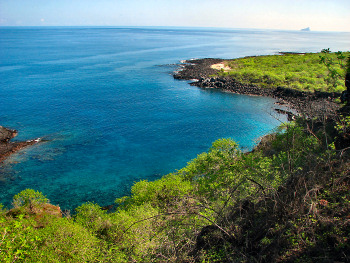
Cove at Cerro Tijeretas, where Dawrin first set foot on the Galapagos
It is not very hard to experience the various climates and biomes of the islands. On the larger islands, all one has to do is travel towards the center of the island, that is to say, towards its current, or former, volcanic cone, to progress from one type to another. Isla Isabela [Albemarle] was one of the most interesting places to do that, as it is the largest island of the archipelago and the least developed of the populated islands. The nearby islets mentioned by Fitz-Roy are now a popular dive site, which I found to be brimming with marine life.
Capt. R. Fitz-Roy:"Having taken on board live pigs and a quantity of vegetables, we weighed and stood towards Albemarle Island [Isla Isabela]. Four small islets, the remains of volcanoes, lie near the low south-east extreme of this island, and together with Brattle Islet, are extremely useful in warning vessels of their approach to a very dangerous piece of coast. So low are the south-eastern extremities of Albemarle Island that they are not discernible until you see the surf on the shore. A heavy swell setting towards the land, and generally light winds, add to the danger of getting near this coast; but there is anchorage in case of necessity.Albemarle Island is a singular mass of volcanic ejections. Six volcanoes have there raised their summits from two to four thousand feet above the ocean, and from them immense quantities of lava have from time to time flowed towards the sea; so that this island, large as it is, may be literally described by saying that it consists of six huge craters, whose bases are united by their own overflowed lava. The southern side, which is exposed to the trade wind, and completely intercepts it, with all the clouds it brings, is thickly wooded, very green, and doubtless has fresh water; but how is that water to be obtained where such a swell rolls upon the shore?"
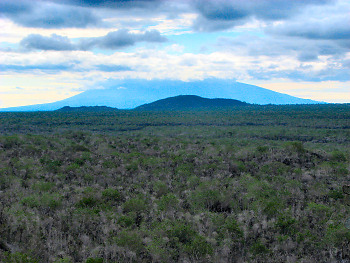
Cerro Azul, one of the volcanos of Isla Isabela
Isla Santiago [James] is a place that Darwin spent a fair amount of time exploring. However, today it is only practical to go ashore there if one is a passenger on a cruise boat. So, I had to be satisfied with the view from nearby Isla Bartolome. That did give me a good opportunity to see one of the harshest environments of the islands, namely the dry, open lava fields.
Mr. C. R. Darwin:"On the 8th we reached James Island [Isla Santiago]. Captain FitzRoy put Mr. Bynoe, myself, and three others on shore, leaving with us a tent and provisions, to wait there till the vessel returned from watering. This was an admirable plan for the collections, as we had an entire week of hard work. We found here a party of Spaniards, who had been sent from Charles Island to dry fish, and to salt tortoise-meat.At the distance of about six miles, and at the height of nearly 2000 feet, the Spaniards had erected a hovel in which two men lived, who were employed in catching tortoises, whilst the others were fishing on the coast. I paid this party two visits, and slept there one night. In the same manner as in the other islands, the lower region is covered by nearly leafless bushes: but here many of them grow to the size of trees. I measured several which were two feet in diameter, and some even two feet nine inches. The upper region being kept damp, from the moisture of the condensed clouds, supports a green and flourishing vegetation. So damp was the ground, that there were large beds of a coarse carex, in which great numbers of a very small water-rail lived and bred. While staying in this upper region, we lived entirely upon tortoise-meat. The breastplate roasted (as the Gauchos do carne con cuero), with the flesh attached to it, is very good; and the young tortoises make excellent soup; but otherwise the meat to my taste is very indifferent."
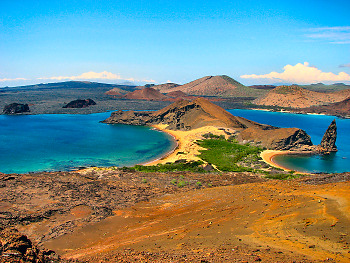
Islas Bartolome and Santiago in the Galapagos
It is the flora and fauna that provide the primary reason for visiting the islands, however. In the case of the Giant Tortoises, one of the iconic creatures of the archipelago, the distinctive shell shapes that have evolved on the various islands, a response to different botanical conditions, provided Darwin with an important piece of evidence to help him formulate his ideas. The only examples I saw in the wild were on Isla Santa Cruz. On that large island there is abundant low vegetation and the tortoises do not require the distorted shells which would allow them to raise their neck to feed on taller plants. It is estimated that the tortoises have lifespans of perhaps 150 years, or more. Consequently, it is possible, though increasingly unlikely, that some of the individuals that Darwin saw when he visited are still roaming the islands today.
Mr. C. R. Darwin:"I will first describe the habits of the tortoise (Testudo Indicus) which has been so frequently alluded to. These animals are found, I believe, in all the islands of the Archipelago; certainly in the greater number. They frequent in preference the high damp parts, but likewise inhabit the lower and arid districts. I have already mentioned* proofs, from the numbers which have been taken in a single day, how very numerous they must be. Some individuals grow to an immense size: Mr. Lawson, an Englishman, who had at the time of our visit charge of the colony, told us that he had seen several so large, that it required six or eight men to lift them from the ground; and that some had afforded as much as two hundred pounds of meat. The old males are the largest, the females rarely growing to so great a size. The male can readily be distinguished from the female by the greater length of its tail. The tortoises which live on those islands where there is no water, or in the lower and arid parts of the others, chiefly feed on the succulent cactus. Those which frequent the higher and damp regions, eat the leaves of various trees, a kind of berry (called guayavita) which is acid and austere, and likewise a pale green filamentous lichen, that hangs in tresses from the boughs of the trees.""It was confidently asserted, that the tortoises coming from different islands in the archipelago were slightly different in form; and that in certain islands they attained a larger average size than in others. Mr. Lawson maintained that he could at once tell from which island any one was brought. Unfortunately, the specimens which came home in the Beagle were too small to institute any certain comparison. "
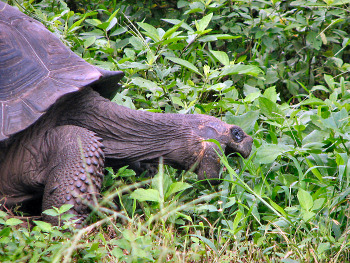
A Giant Tortoise feeding on Isla Santa Cruz
Neither Darwin nor Fitz-Roy had anything good to say about another of the archipelago's unique species, the Marine Iguana. The World's only aquatic lizard, this iguana is abundant on just about every shoreline in the Galapagos. I did not find them to be as revolting as the Beagle crew did, however. They have an easy life, and they know it. Most of the time they can be found sunning themselves on a black lava rock, lounging about in a totally nonchalant manner. They also provide the most facile photographic opportunities of just about any creature I have yet seen.
Capt. R. Fitz-Roy:"This part of the island is low, and very rugged. We landed upon black, dismal-looking heaps of broken lava, forming a shore fit for Pandemonium. Innumerable crabs and hideous iguanas started in every direction as we scrambled from rock to rock. Few animals are uglier than these iguanas; they are lizard-shaped, about three feet in length; of a dirty black colour; with a great mouth, and a pouch hanging under it; a kind of horny mane upon the neck and back; and long claws and tail. These reptiles swim with ease and swiftness—but use their tails only at that time."Mr. C. R. Darwin:
"This lizard is extremely common on all the islands throughout the Archipelago. It lives exclusively on the rocky sea-beaches, and is never found, at least I never saw one, even ten yards inshore. It is a hideous-looking creature, of a dirty black colour, stupid and sluggish in its movements. The usual length of a full-grown one is about a yard, but there are some even four feet long: I have seen a large one which weighed twenty pounds. On the island of Albemarle they seem to grow to a greater size than on any other. These lizards were occasionally seen some hundred yards from the shore swimming about; and Captain Collnett, in his Voyage, says, "they go out to sea in shoals to fish." With respect to the object, I believe he is mistaken; but the fact stated on such good authority cannot be doubted. When in the water the animal swims with perfect ease and quickness, by a serpentine movement of its body and flattened tail,—the legs, during this time, being motionless and closely collapsed on its sides."
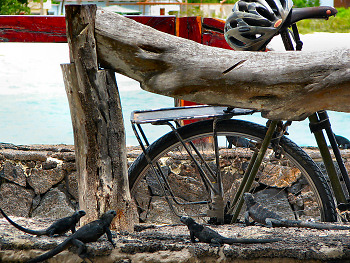
Young Marine Iguanas examine my bike
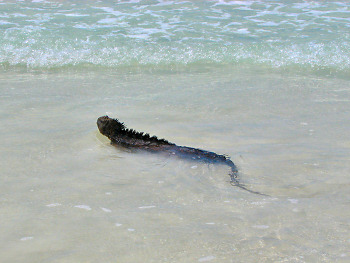
A Marine Iguana takes to the Sea
The Land Iguanas were not treated with much more regard by the crew of the Beagle. Though, again, to me they seemed harmless enough. Darwin did not personally visit Isla Santa Fe [Barrington,] as I did. If he had, he would have seen a species of land Iguana that is endemic to that small island, which surely would have been of interest to him.
Mr. C. R. Darwin:"These lizards, like their brothers the sea-kind, are ugly animals; and from their low facial angle have a singularly stupid appearance. In size perhaps they are a little inferior to the latter, but several of them weighed between ten and fifteen pounds each. The colour of their belly, front legs, and head (excepting the crown which is nearly white), is a dirty yellowish-orange: the back is a brownish-red, which in the younger specimens is darker. In their movements they are lazy and half torpid. When not frightened, they slowly crawl along with their tails and bellies dragging on the ground. They often stop, and doze for a minute with closed eyes, and hind legs spread out on the parched soil."
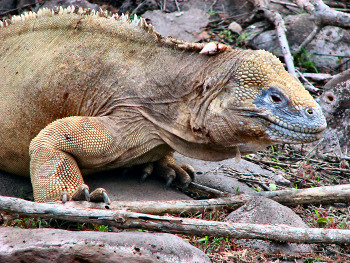
An iguana endemic to Isla Santa Fe
I managed to see and positively identify four, out of thirteen species, of the famous "Darwin's finches" of the Galapagos. That was adequate for me, as I did not need to develop any World-changing theories based upon the appearances of their beaks. Darwin did, however, and he was fortunate that the birds are as tame as they are, for only with close observation are their differences apparent.
Mr. C. R. Darwin:"A group of finches, of which Mr. Gould considers there are thirteen species; and these he has distributed into four new sub-genera. These birds are the most singular of any in the archipelago. They all agree in many points; namely, in a peculiar structure of their bill, short tails, general form, and in their plumage. The females are gray or brown, but the old cocks jet-black. All the species, excepting two, feed in flocks on the ground, and have very similar habits. It is very remarkable that a nearly perfect gradation of structure in this one group can be traced in the form of the beak, from one exceeding in dimensions that of the largest gros-beak, to another differing but little from that of a warbler."
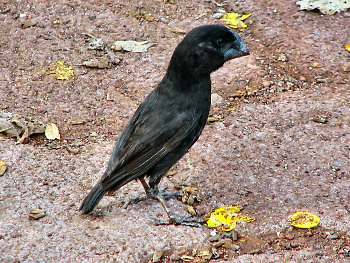
A Large Ground Finch, one of "Darwin's Finches"
Darwin Reflects
Mr. C. R. Darwin:"Our voyage having come to an end, I will take a short retrospect of the advantages and disadvantages, the pains and pleasures, of our five years' wandering. If a person should ask my advice, before undertaking a long voyage, my answer would depend upon his possessing a decided taste for some branch of knowledge, which could by such means be improved. No doubt it is a high satisfaction to behold various countries, and the many races of mankind, but the pleasures gained at the time do not counterbalance the evils. It is necessary to look forward to a harvest, however distant it may be, when some fruit will be reaped, some good effected.Many of the losses which must be experienced are obvious; such as that of the society of all old friends, and of the sight of those places, with which every dearest remembrance is so intimately connected. These losses, however, are at the time partly relieved by the exhaustless delight of anticipating the long wished-for day of return. If, as poets say, life is a dream, I am sure in a voyage these are the visions which serve best to pass away the long night. Other losses, although not at first felt, tell heavily after a period; these are, the want of room, of seclusion, of rest;—the jading feeling of constant hurry;—the privation of small luxuries, the comforts of civilization and domestic society, and, lastly, even of music and the other pleasures of imagination. When such trifles are mentioned, it is evident that the real grievances (excepting from accidents) of a sea life are at an end. The short space of sixty years has made an astonishing difference in the facility of distant navigation. Even in the time of Cook, a man who left his comfortable fireside for such expeditions, underwent severe privations. A yacht now with every luxury of life might circumnavigate the globe. Besides the vast improvements in ships and naval resources, the whole western shores of America are thrown open, and Australia has become the metropolis of a rising continent. How different are the circumstances to a man shipwrecked at the present day in the Pacific, to what they were in the time of Cook! since his voyage a hemisphere has been added to the civilized world."
It has been said, that the love of the chase is an inherent delight in man—a relic of an instinctive passion. If so, I am sure the pleasure of living in the open air, with the sky for a roof, and the ground for a table, is part of the same feeling: it is the savage returning to his wild and native habits. I always look back to our boat cruises, and my land journeys, when through unfrequented countries, with a kind of extreme delight, which no scenes of civilization could have created. I do not doubt that every traveller must remember the glowing sense of happiness he experienced, from the simple consciousness of breathing in a foreign clime, where the civilized man has seldom or never trod.
There are several other sources of enjoyment in a long voyage, which are, perhaps, of a more reasonable nature. The map of the world ceases to be a blank; it becomes a picture full of the most varied and animated figures. Each part assumes its true dimensions: continents are not looked at in the light of islands, or those islands considered as mere specks, which are, in truth, larger than many kingdoms of Europe. Africa, or North and South America, are well-sounding names, and easily pronounced; but it is not till having sailed for some weeks along small portions of their coasts that one is thoroughly convinced how large a portion of our immense world these names imply."
My feelings during, and after, the Tour were like Darwin's in some ways, but different in others. Though I did not, as he suggested, have a particular profession that would be enhanced by my undertaking, I nevertheless, found just about every minute of the Tour to be fascinating and rewarding in its own right. Darwin could, of course, have been right on target with his observation that the ease of traveling had been increasing drastically, and continued to do so, finally reaching today's largely effortless level, which surely would have amazed him. That may have skewed my perceptions of the experinces of long-term travel realtive to his. On the other hand, I traveled primarily by bicycle, often in places where that mode of transport is discouraged, to say the least. In that regard, I surely experienced more than my share of deprivations along the way. That mattered not to me, and I probably enjoyed my Tour all the more because of them. Then again, apart for missing my family and friends, I am not really the type of person who gets homesick very often. That may be beacuse I really do see the whole Earth as my home.
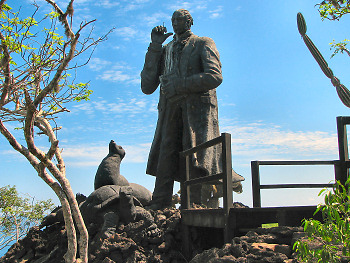
Darwin Statue at Cerro Tijeretas
One day, while still in the Galapagos, the tour
boat I was on cruised into Barrington Bay at Isla Santa Fe. There, as was
usually the case, were a few other boats already at the anchorage. 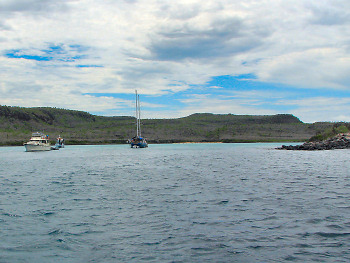
Barrington Bay, Isla Santa Fe
It was not until I was very close to them that I
could make out the name of the rather attractive sailboat among them: The Beagle. Not the original, of course, not
nearly as grand a ship, and surely never to be as famous, but it paid
homage to its namesake in the best way it could.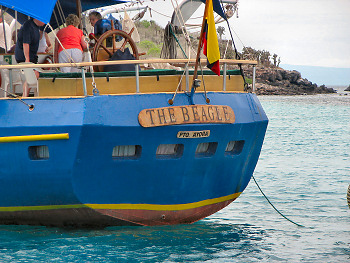
Another Beagle, moored in Barrington Bay
That was a nice way for me to mark my farewell to the ghost of the more famous vessel. For, after that point, the final 13,000 kilometers of my Tour would take me far away from the course of my companion ship. It is unfortunate that the Beagle did not survey Asia or more of Africa, as I'm sure they would have witnessed many interesting things, which I would have enjoyed reading about today. Nevertheless, I feel proud to have followed in the path of such a worthy ship and its talented crew.
Continued From:
Part 1
Previous | Next
Main Index | Pre-Tour Index
Post-Tour Index | Articles Index
Slideshows
Main Index Pre-Tour Post-Tour Articles Previous Next |
About the Ship
Vital Statistics
Built: Woolwich Naval Dockyard, River Thames, England
Launched: May, 11 01820
Class and type: Cherokee-class brig-sloop (converted to a barque after voyage 1)
Tons burthen: 235 tons (242 tons for second voyage)
Length: 27.5 m
Beam: 7.5 m
Draught: 3.8 m
Masts: (length/diameter)
Lower-fore: 14.1 m/36 cm
Top-fore: 3.96 m/25 cm
Lower-main: 16.6 m/45 cm
Top-main: 3.96 m/25 cm
Topgallant-fore: 2.3 m/15 cm
Topgallant-main: 2.3 m/
15 cm
Bowsprit: 3.7 m/23 cm
Fore-lower Yard: 4.9 m/
28 cm
Fore-topsail Yard: 4.2 m/
20 cm
Fore-topgallant Yard: 3 m/
15 cm
Main-lower Yard: 5.2 m/
28 cm
Main-topsail Yard: 4.2 m/
20 cm
Main-topgallant Yard: 3 m/
15 cm
Main driver Boom: 5.7 m/
28 cm
Driver gaff Boom: 3.1 m/
19 cm
Jibboom: 2.7 m/20 cm
Spritsail-yard: 4.11 m/15 cm
Mizzenmast-lower: 4.6 m/
41 cm
Mizzen-topmast: 3 m/25 cm
Mizzen driver boom: 3 m/
19 cm
Crews
(upon departure)
Voyage 1:
Commander Pringle Stokes
Lt. E. Hawkes
Lt. W.G. Skyring
Master S.S. Flinn
E. Bowen, Surgeon
B. Bynoe, Asst. Surgeon
J. Atrill, Purser
J.L. Stokes, Midshp.
R.F. Lunie, Volnt.-1st.
W. Jones, Volnt.-2nd
J. Macdougall, Clerk
J. May, Carpenter
10 Royal Marines
40 men and boys
Voyage 2:
Commander Robert Fitz-Roy
Lt. J.C. Wickham
Lt. B.J. Sulivan
Master E.M. Chaffers
R. McCormick, Surgeon
B. Bynoe, Asst. Surgeon
G. Rowlett, Purser
J.L. Stokes, Mate
A. Derbishire, Mate
P.B. Stewart, Mate
A. Mellerersh, Midshp.
P.G. King, Midshp.
A. B. Usborne, Asst. Master
C. Musters, Volnt.-1st.
J. May, Carpenter
E.H. Hellyer, Clerk
8 Royal Marines
35 men and boys
3 captives from
Tierra del Fuego
R. Mathews, Missionary
A. Earl, Artist
G.J. Stebbing, Instrument Maker
S. Covington, Fiddler
C. R. Darwin, Naturalist
Voyage 3:
Commander John Clements Wickham
Lt. J.L. Stokes
Lt. J.B. Emery
Lt. H. Eden
Master A. B. Usborne
B. Bynoe, Surgeon
T. Tait, Asst. Surgeon
J.E. Dring, Clerk
B.F. Helpman, Mate
A.T. Freeze, Mate
L.R. Fitzmaurice, Mate
T.T. Birch, Mate
W. Tarrant, Asst. Master
J. Weeks, Carpenter
C. Keys, Clerk
T. Sorrell Boatswain
8 Royal Marines
40 men and boys
Lt. G. Gray, and party to explore the interior of Australia
(Data from Thompson and Wikipedia)
Sources of Information
Keith S. Thomson
HMS Beagle: The Story of Darwin's Ship
The Complete Works of Charles Darwin Online
Collection Index
John Lort Stokes
Discoveries in Australia
Vol 1. & 2
AboutDarwin.com
The HMS Beagle Project
Previous | Next